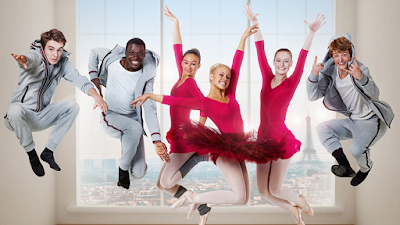Lisa Dawn's Blog: The Princess Blog, page 47
April 1, 2021
Enchanted Kingdoms Review: Part 1
The Enchanted Kingdoms box set is a massive undertaking by the Enchanted Quill Press to collect a large group of fairy tale authors to adapt 20 different fairy tales in an anthology to support an Puzzle Piece United, a children's autism charity. For a while, I was juggling with the idea of signing up to be one of the authors in this set, myself, and now I am kicking myself for not doing it. These 20 top tier books not only retell a multitude of beloved stories, but they do so in a unique and creative way that makes each one feel fresh and new. I haven't finished the entire set yet, so I decided that the best way to review it would be in chunks because I might forget the first few book by the time I get to the last one. Therefore, this will be the first post in a four-part series of mini reviews in which I summarize my thoughts on five books within this set. Before I begin, I have to say that it is absolutely worth the price for 20 full-length novels. Each one could easily thrive on its own, but together, they are unbeatable.
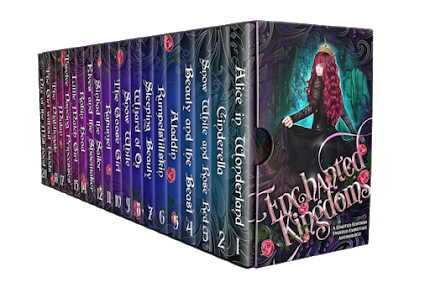
We're All Mad Here by J.A. Armitage and J.A. CulicanThis "Alice in Wonderland" retelling takes the disjointed storytelling out of the Lewis Carroll's trippy novel and places the it in modern times. A young lady is tasked with helping her mother clean out the house of an old woman who was recently deceased when she accidentally falls through a mirror where she finds herself trapped in the Victorian era. It's a classic time travel romance filled with not-so-subtle references to all the colorful characters from the original novel in the forms of eccentric people. The story amps up near the end when she finds herself stuck in a competition to marry a powerful dragon king. She decides that power is not something she desires and follows her heart to find her way back home. I believe this is one of the shortest books in the set, but the story contains plenty of romance and drama to make up for it.
Ash and Cynder by Kimbra SwainThis is by far the most unique and imaginative retelling of "Cinderella" I have ever read. It was was a little too out there for me at first, but the characters become more relatable as the story goes on. It takes place in a world of gods and goddesses who give trials to the women of the land to win an opportunity for wealth and happiness. Ashtyn is a meek young lady who seems like the worst possible candidate for a test of endurance, but the fates are on her side for reasons that we do not fully comprehend until the end of the book. She has a few love interests who knew her when she was younger to counteract the most popular complaint about "Cinderella," which is that she had only met the prince once when she married him. The book combines surreal politics and original mythology in a way that is reminiscent of The Hunger Games and Pan's Labyrinth .
Snow and Red by Eileen Mueller and A.J. PonderThough it incorporates a lesser known fairy tale, which seems like a promising concept, this version of "Snow White and Rose Red" barely resembles the tale from the Brothers Grimm. Here, Snow and Red are modern-day rebellious teens who like to go clubbing in skimpy outfits and choose questionable lovers. It felt like I was reading something that aired on the CW instead of an adaptation of a fairy tale. There were still some things that I liked about it, though. The girls find themselves wrapped up in the middle of a mystery involving their parents, their mysterious powers, and shapeshifting dragons. They pair up with a couple of bad boys who know more about their powers than they do and go on a series of misadventures that enrages their mother when she finds. The ending leaves room for a sequel, but I'm not sure how that would work since none of the books in this anthology have been released as standalones.
Tainted by Beth HaleThis is a charming take on "Beauty and the Beast" if it had taken place in the real world. Carlynn struggles to care for her mentally ill father when she learns that he was sued for damages by his extremely young boss. She goes to the young boss's mansion to make amends and meets Sean, an angsty young CEO covered in scars from a bad car accident that indirectly led to his parents' death. One of Sean's housekeepers hires Carlynn with the ulterior motive of bringing Sean out of his shell. Over time, the two teenagers help each other work through their past traumas and bring out their true selves. I thought this book was similar to the first one in the anthology because it contained modern-day human versions of every character from "Beauty and the Beast" in the same way that We're All Mad Here contained human versions of every character from "Alice in Wonderland."
Enchanted Wishes by Zara QuentinThis starts out as a completely original story about a slave woman who breaks free of her master through the power of a magic lamp that turns her into a different type of slave. A few chapters in, however, the book becomes a standard retelling of "Aladdin" with more of an emphasis on the Disney version than the original fairy tale. It's a shame that Aladdin has such a cookie cutter arc when Ziba, the genie, has a fascinating backstory that results in many questionable or morally gray decisions. Aside from her genie powers. Ziba is psychic, an ability that she maintains after her transformation that feeds into many of her decisions when it comes to Aladdin and obtaining her freedom. The book's ending incorporates something that people have suggested that Disney should have done in their version for years and provides a satisfying resolution for all the characters.
March 29, 2021
These Fan-Made Music Videos Bring Back the Magic of Disney Princesses!
If you've found the quality of Disney entertainment a bit lackluster lately, you aren't alone. There was barely any hype surrounding the awesome new princess movie they just launched on Disney+, especially compared to some of their previous movie openings. Of course, it isn't entirely their fault that they can't have big movie premieres during a time of lockdowns and safety measures, but combined with theme park closures, it leaves us feeling a little empty inside. Have no fear because fans will always be here to bring back the pixie dust and excitement of the old days even when the studios are too busy counting their losses to notice. Last week brought two groups of powerhouse princess cosplayers singing about the good old days and making some poignant observations on how Disney Princesses have evolved over the last few decades. Even though they were produced by different, though equally talented, independent studios, the videos perfectly illustrate the evolution of the classic '50s housewife-style princess into the modern-day warrior princess.
"Princess Intervention!" is the third episode of the Princess Academy webseries by PattyCake Productions. This series is a little different from their Villains Lair series in that the episodes are all standalone sketches that have little to no relation to each other. What's really great about the series is that each episode contains an original song, with this one being no exception. The entire video is a throwback to the cleaning obsession shared by many of the golden age princesses. Snow White, Cinderella, Giselle, and Rapunzel scold Merida for not cleaning her room. I love how careful they were in selecting which princesses to give Merida the intervention, since all four of these lovely ladies sang a song about cleaning at some point in her movie. The video contains a beautiful reference to the soap bubbles that reflected Cinderella as she cleaned the floor in "Sing Sweet Nightingale" as well as Snow White's "Whistle While You Work" with cameos from the seven dwarfs. Merida is my least favorite of the Disney Princesses, so I had no qualms with seeing her getting put in her place.
Another princess fan video that came out last week was a tribute to Raya and the Last Dragon from Pixel Playhouse, a group that makes fan tributes that are similar to PattyCake Productions. This video takes a look at the modern princesses who lack love interests and fight their own demons such as Elsa, Violet, Mulan, and, of course, Merida. The actresses in it are insanely talented with gorgeous singing voices, especially the girl who plays Raya. She makes some clever observations about how the world is divided in her movie just like the world we live in now when Elsa points out that times of darkness are when we need princess stories the most. It was interesting to see Violet included in a princess video since she was supposed to be part of Disney's "Princess Academy" short even though she is not part of the official Disney Princess lineup. This song in this video has a poignant tagline about how "heroines aren't born; they're made," which differentiates the Disney Princess characters, who are born or marry into their roles, from the Disney heroines, who marked their place in Disney history through their actions. These days, the line between a princess and heroine is virtually nonexistent.
Collectively, these two music videos represent the distinct shift in princess culture between the classic and modern eras of Disney animation. The character that unites both fan videos is Merida from Brave, which came out in 2012. I think that was the year that everything changde for Disney and princess culture in general. After that, we stopped seeing clear-cut villains in animated movies, and princesses stopped needing love interests for their films to be successful. Movies after 2012 placed more focus on being strong and independent than on the fantasy of finding love and living in a clean castle, something that was idealized and deconstructed most recently in WandaVision on Disney+. I enjoyed how these videos celebrate both forms of being a princess from the feminine archetypes to more gender-neutral ones, though I have to admit that seeing a version of Raya sing made me really wish that Raya and the Last Dragon had been a musical.
You can always count on talented fans to build hype and excitement for popular fandoms. Both PattyCake Productions and Pixel Playhouse are extraordinarily talented groups that share their love of the Disney princesses in the most creative ways possible. It was a magical experience to see how these very different groups of princesses were brought to life with screen-accurate costumes, faces, and voices. These music videos brought unexpected joy to an otherwise uneventful weekend, and I hope that you will love and support their work just as much as I do.
March 28, 2021
Review: Time Princess - Little Women Visual Novel
The Time Princess app has been really picking up the pace with its releases of new visual novels. Shadows of London just wrapped up, and we already have a new story inspired by Louisa May Alcott's classic novel, Little Women. Both Little Women and Shadows of London take place in the 1800s, but the fashions and storytelling techniques are completely different due to the drastically opposite lives of their protagonists. Caroline from Shadows of London is a wealthy English debutant who wears glamorous gowns in the hopes of being courted during the social season, while Jo is an independent American career woman with a relatively low income. Though Little Women does not use the game's encyclopedia feature like Shadows of London to provide history lessons about the time period, the overall story and conclusion are a great deal more satisfying.

The Little Women visual novel gives players an opportunity to step into the life of Jo, the most independent of the four March sisters from the novel of the same name. As a writer, myself, I found Jo's struggle to publish her books and share her stories with the world extremely relatable and was eager to help her find success. She starts out working for a soulless newspaper publisher who cares more about money than quality writing, but her path veers into two potential new directions when she meets two young men who are supportive of her work. Depending on which love interest you choose for her, Jo can continue to attempt publishing her novel independently or switch careers to become a playwright. As someone who has written both screenplays and novels, I found that both of these paths were a mirror reflection of my own endeavors and goals. It doesn't hurt that both men who want to help her achieve these dreams are very charming and attractive.
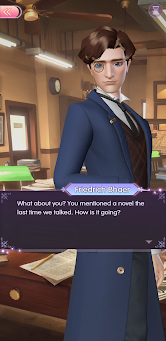
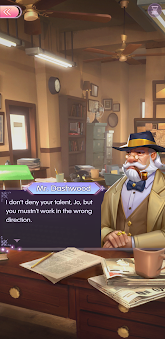
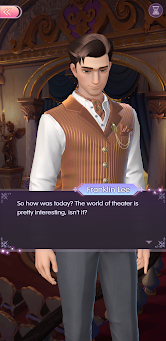
I have never read Little Women, so I have to rely on what little knowledge I could access to determine how accurate this visual novel is to the original story. It places more focus on Jo than the other three March sisters since she is the one the player controls. Amy March makes a few appearances as a static talking head, while Beth and Meg are only mentioned in the dialogue or narrations. Of the two love primary love interests, I believe only Friederich Bhear was the only one from the original novel. Friederich is an intelligent philosopher who becomes Jo's new beau after she turns down the advances of her childhood sweetheart, Laurie. Fans of the original book who were disappointed with the way Jo and Laurie left off have an opportunity to redeem their relationship in the visual novel, but he doesn't have any of the pretty romantic artwork that the primary two love interests get, so I found this path one of the least satisfying endings. Franklin Lee, the stage director, is a brand new character for this visual novel who gives Jo an alternative but equally appealing career path. He is charming and outgoing but lacks the soft humility that Friederich possesses.
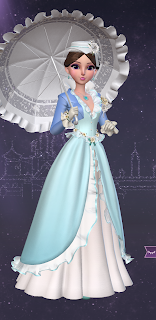
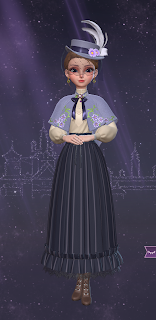
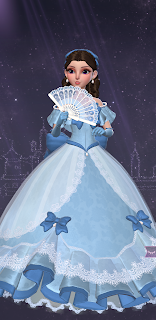
Like the last few visual novels in Time Princess, Little Women has five outfits that players can craft. I liked that they emphasized Jo's personality as a career-focused woman who doesn't care for frills. She does, however, have one frilly dress that satisfies our feminine desires in the form of a costume for Franklin's play. It is an oversized blue Disney Princess-inspired gown covered in big bows, lace, and a matching fan. This is the first open fan I've seen in the game, as the two from the Queen Marie novel are held shut to her side. I also liked the frilly white parasol that she holds behind her simple blue and white tea dress. The levels in this story are fairly easy to pass once you have the outfits, but I found the clothing items to be some of the most difficult to craft among the stories that Time Princess has released so far. Almost every item requires you to craft something else first, forcing me to make endless copies of the two black skirts in the game just so I could use them to make something else. That did get a little frustrating, but I was still able to complete every set in about two weeks.
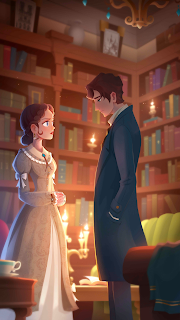
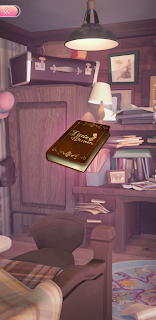

Overall, I think Little Women has something to offer any player of Time Princess, whether they are fans of the original novel or keep things strictly professional. It has a number of satisfying endings depending whether you pursue the path of an author or a screenwriter and if you want to have a romantic relationship with your business partner or not. Amy's resolution changes as well depending on the path that Jo takes, so you can pick the resolution for two of the March sisters to some extent. I loved exploring the various trials and tribulations of the worlds of publishing and theater as well as Jo's relationships with two very different types of men. I can't say if reading the original book would have heightened or lowered my enjoyment of the visual novel, but I do think it's one of the best stories Time Princess has released since Romy and Julius.
March 21, 2021
Review: Embers: Beastly Curses
Last week, I received an advance copy of Embers: Beastly Curses by Sky Sommers in exchange for an honest review. This is the second book in a new fairy tale series called the Magic Mirrors Saga. I felt that there was a lot I missed by not reading the first book even though this one is supposed to work as a standalone. It is a creative and unique retelling of "Little Red Riding Hood," but it loses direction so many times that I wasn't sure which fairy tale I was supposed to be reading after I got several chapters in. Magic Mirrors reads like an ambitious attempt to reboot Once Upon a Time with new fairy tale characters who are related in various ways, and it suffers from the same flaws as a result. The further I got, the more difficult it was to discern who the main character was supposed to be. It is unique for being the first time I've ever seen the "Red Riding Hood" character as a little boy, but the story is more focused on the wolf, Grace, while constantly jumping around to other witches, fairy godmothers, and princesses with their own convoluted backstories.
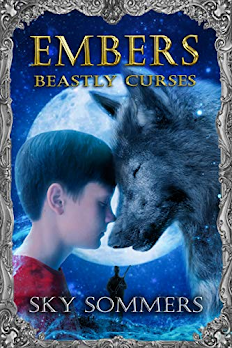
The first thing I noticed about Embers is that it is written by someone who hasn't taken a lot of writing classes. It is filled with capitalized letters, exclamation points, drawn-out words, and expository dialogue that violates the "show, don't tell" rule. Still, the book is written with a great deal of passion for fairy tales and princesses. Sky Sommers is clearly a huge fan of Once Upon a Time who wanted to create her own version. The story starts with a boy named Henry telling his father, Peter, about a friendly wolf he met in the woods. Since "Little Red Riding Hood" is a cautionary tale, my first instinct was to fear for Peter's safety. Those fears were put to rest when the wolf is revealed as Grace, Henry's mother, and Peter's long-lost wife, who was cursed to live out her days in a wolf's body. What follows should have been a touching story of a mother protecting her son without being able to communicate with him through words, but instead, it jumps in a hundred different directions.
What threw me off the most about Embers was the setting. There are several references to contemporary movies like Shrek and Beauty and the Beast, but the characters' lifestyles feel old-fashioned, with little or no references to modern technology, and they still have medieval kingdoms. It was explained later that there are multiple dimensions in this world, yet it was never clear which dimension the story took place in at any given time. With all the references to Disney, I thought the Magic Kingdom referred to the Disney theme park until one of the characters explained that it is a fairy tale dimensions in this world. Another point of confusion is how Grace is somehow both Cinderella's stepmother and Henry's father, even though there are no references to Henry having two sisters and a stepsister as he lives alone with his father in the woods. In another chapter, Belle is revealed as Cinderella's mother-in-law with a cursed family line affecting Cinderella's children, which is when the story really veers away from the mother/son relationship between Grace and Henry.
Regardless of its poor execution, Embers brings some creative new ideas to light when it comes to rewriting fairy tales. What if the wolf never wanted to hurt Red Riding Hood at all, and the danger it posed was just a big misunderstanding? Instead of exploring this, the book takes an easy way out when Grace obtains a potion that will turn her human again so she can reveal herself to her family. It would have been more interesting for her to look for a more creative way to reveal her identity with the handicap of being a wolf. Spending more time on that would have resolved the convolution of the book's middle section that brought in Belle and Cinderella when they had no real reason to be there. There also seemed to be no antagonist, which dampened the significance of Grace's desire to protect Henry in her wolf form. A threat to Henry's life that only Grace could save him from would have really raised the stakes for the story.
Overall, Embers is an attempt to revisit the ideas in Once Upon a Time without fully fleshing out the individual characters and setting. As much as I liked the idea of Henry's mother as the wolf, the story veered off course too many times to become fully invested. I think the author of this book would benefit from writing for a younger audience. and including fewer unnecessary characters and exposition. Using the name "Magic Kingdom" for the fairy tale dimension also caused a great deal of confusion when the book has so many unironic references to Disney movies, implying that Disney and its subsidies exist in this universe. I would recommend this book to fans of Once Upon a Time with low expectations.
March 14, 2021
Review: The Enchanted Crown
The Enchanted Crown is the fourth and final book in The Stolen Kingdom series by Bethany Atazadeh. This is an excellent book for fans of any other book in the series. As a fan of The Stolen Kingdom and The Jinni Key, I was happy to catch up with Arie and Rena for one last adventure. I was less impressed with The Cursed Hunter, but Nesrin was not featured enough to detract from my interest in this conclusion. The Enchanted Crown contains chapters from the perspectives of all three protagonists and several love interests, which keeps the story moving at a quick pace. The variety of perspectives creates a unique reading format since the story itself is a pretty traditional "final battle" narrative. I recently noticed that the subtitle for this book claims that it is a "Sleeping Beauty" retelling. That claim is a bit of a stretch, but that has nothing to do with the quality of the novel itself.

The Enchanted Crown is the exciting climax of The Stolen Kingdom, The Jinni Key, and The Cursed Hunter. It picks up where all three of these books leave off and takes the three princesses on a quest to stop the wicked Jinni Queen from conquering the worlds of humans and Mere. Princess Arie has become Queen of Hodafez and must team up with her companions to stop the most powerful being in the realms. How and why the heroines defeat the Jinni Queen is less interesting than the antics they get up to along the way. All three princesses are tested to their limits when they are stripped of their special abilities. Prior to this book, Arie was forced to have a "severance," a dangerous procedure that removes powers from anyone blessed with a Jinni gift and usually results in death or suicide. With the way the severity of the procedure was stressed in The Stolen Kingdom, I expected Arie to be in a much worse state than she was. Rena, the "Little Mermaid" character from this series, has her necklace of spells forcefully taken from her and is thrust into the middle of the ocean without her tail. Nesrin from The Cursed Hunter must face her feelings for Malakai that she adamantly denied in her own book.
Arie's plan to reach the Jinni Queen is a little crazy, but that's also what makes it so interesting. Using Rena's magical relic, the group of renegade royals set a trap to catch any Jinn in the area and attempt to negotiate with them to overthrow their queen. The plan goes as well as you would expect a forced alliance initiated by a trap to go. Some Jinn betray the group, some deceive them, and others agree to help them. Included among the numerous Jinn who fall into the trap are Gideon, Arie and Rena's reluctant ally from the first two books, and Malakai, the cursed prince from the third book. The team thinks they have a surefire victory when they capture the prince, but just wants to get back to Nesrin, which would have been touching if they weren't the weakest love story in the series. Fortunately, the story focuses on the other couples as well. Kadin plays a vital role in helping Arie deal with the traumatic loss of her powers while simultaneously trying to stage a coup, and Rena continues to learn about the nuances of love as she navigates her newfound romance.
In spite of her elaborate plan to team up with the rest of the Jinn, Arie must face the Jinni Queen on her own in the end. By doing so, she discovers the answers to all of the questions she had about her past in the first book and learns to love and understand herself better in the process. Though it features other characters and side stories, this is ultimately Arie's book and provides a satisfying conclusion to the open ending that was left in The Stolen Kingdom. Rena is my favorite character in the series, but Arie has the most growth and achievements by far in this conclusion. She proves herself to be a worthy queen, moves beyond her shortcomings over her relationship with Kadin, and finally learns the truth about her past. All three princesses are tested in their own way, but Arie comes out as the biggest winner of all, which made the climax my favorite part of the book.
The Enchanted Crown is a must-read for fans of any of the other three books in this series. It provides a satisfying conclusion for all three princesses, especially Arie, and builds upon the unique lore that Bethany Atazadeh created with her world of humans, Jinn, and Meremaids. Arie and Rena's bizarre attempt to capture Jinn and force them to negotiate is a unique tactic that is just as entertaining as it is reckless. The shifting perspectives in each chapter keep the story interesting even when where there is not a lot happening. Fans of the first book will be especially satisfied with the resolution to Arie's story. Personally, I was happy just spending more time with Rena, one of my favorite little mermaids. Since I read an advance copy of this book, be sure to keep an eye on the Amazon page for its official release on March 23rd.
March 12, 2021
Review: Time Princess - Shadows of London Visual Novel
There have been many recent updates in the Dress Up! Time Princess app with the most notable being that they changed their name to simply Time Princess, which is how I will be referring to it from this point on. Another major update from this week was the second half of the latest visual novel, Shadows of London, a Victorian vampire story. This is the first visual novel in Time Princess that was released in two separate halves since I started playing it. I thought the wait time would be frustrating, but I found that it gave me ample time to craft the items I needed to access the new story levels so I wouldn't get stuck when the rest of the game was released. This is the easiest story I've played so far in Time Princess, but that might be because I've been playing it for so long. I was able to get through all the story levels from each of the two releases within a single evening.
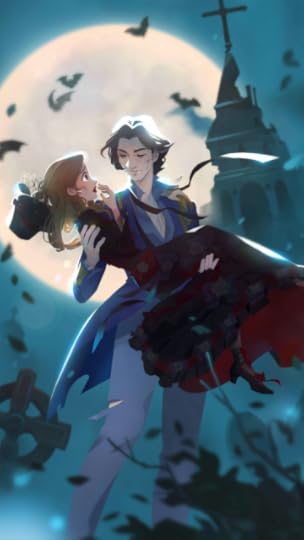
The main character in Shadows of London is Caroline Rayes, a young lady with a tragic past who is sent to stay with her debutante aunt, who wishes to set her up with a stable match. Instead of Jesse Lindvall, the wealthy young man her aunt wants her to be with, Caroline spends the majority of her time with Edward Grey, a friendly doctor, Vincent Savile, a pale-faced mystery man, and Priscilla, a goth girl who is ahead of her time. The closer she gets with these troubled companions, the more she learns about the mysterious virus that has been plaguing the citizens of London and with no cure. There is a lot of lore behind vampires stories, giving each one its own unique appeal. Depending on the setting, the vampires have different reasons for not being able to go outside during daylight hours, methods of feeding on blood, ways to transform mortals, and ways to be defeated. Shadows of London does not explore any of that. In fact, the visual novel doesn't even delve into the existence of vampires in this Victorian version of London until the story is practically over. It focuses instead on the courting rituals of eras long past. In that respect, it is reminiscent of the popular Netflix series, Bridgerton.
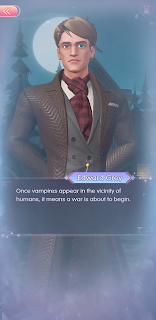
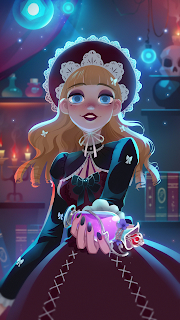
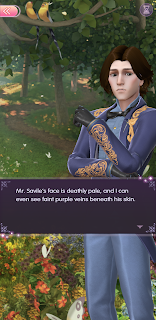
When the second half of the novel was released, I hoped it would answer the many questions I had about the virus and Caroline's past, but instead, it left me with more questions than it answered. The ending was similar to another Time Princess visual novel, Helen of Sparta, in that it doesn't matter which ending or love interest you choose because the story goes unresolved no matter what. I was hoping it would be more similar to the game's last visual novel, Romy and Julius, which had four very satisfying ending options depending on which love interest you chose and whether you prefer happy or bittersweet stories. The only reason to appeal to the love interests in Shadows of London is that the story has two events in which one of them needs to rescue you in order to continue the story. However, I had more trouble getting the bad endings where I didn't get rescued than I did unlocking the rescue sequences. I felt like I got shafted when I realized that no matter who I chose, the novel ends with Caroline alone on a train. I would have even been satisfied with an ending that featured Priscilla, one of the most interesting characters in the story.
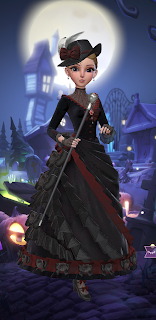
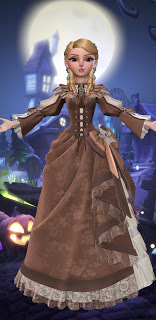
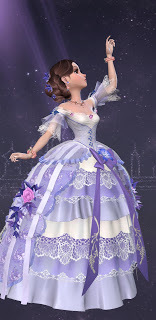
I've always loved Victorian fashion, and the outfits in this dress-up visual novel are no exception. The purple dress is one of my absolute favorites in Time Princess so far with its oversized lace, ribbons, and flower accents. I would love to own a dress like it in real life. The casual brown dress reminds me of Back to the Future III . I love the style and material soft-looking suede material, though I would have preferred a different color. The black mourning dress is the closest craftable outfit to a vampire costume, although there is another one you can win in the game's lottery system that looks a lot prettier and more like something a vampire might wear. I was surprised by how few costumes there were that gave off gothic vampire vibes, but I suppose that's because of the novel's larger focus on the courting season. This is the first visual novel since Gotham Memoirs to use the game's encyclopedia system that allows the player to research historical terminology used throughout the story, which helped to enhance the setting.
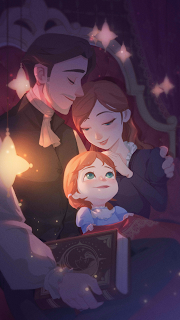
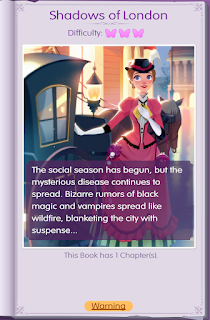
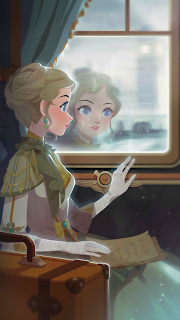
Overall, Shadows of London has a promising premise and well-researched historical setting, but the sci-fi elements of the story are barely explored. The game doesn't give the player a chance to get to know either love interest or get close with them in a romantic setting. The ending is by far the most disappointing aspect of the novel. So many scenes imply that there is a hidden world just below the streets of London, but every time you get close to discovering it, something pulls you back out into the mundane world. Though one mystery of Caroline's past is revealed near the end of the game, her future remains a huge question mark no matter which path you choose.
March 7, 2021
Review: Raya and the Last Dragon
The newest Disney Princess to grace the silver screen is Raya from Raya and the Last Dragon. Since many theaters are still closed due to the pandemic, this is the second theatrical movie available to stream on Disney+ for an additional fee, the first being the live-action remake of Mulan, which I did not think was worth the extra money for Premier Access. Raya is a worthwhile experience that recreates the magic of watching an animated Disney classic in theaters for the first time, even though I watched it at home. It is full of magic, adventure, and heart with gorgeous visual imagery inspired by Southeast Asia. My biggest concern about this movie was that Raya would be a cookie-cutter independent warrior princess with no personality, but I was pleased to learn that she is just as flawed and human as any other well-rounded protagonist. She share some traits with Elena of Avalor, such as her overconfidence and trust issues but has a unique enough story to stand on her own.

The trailer for Raya and the Last Dragon is a pretty accurate depiction of the movie's plot. Raya lives in an enchanted kingdom that was once called Kumandra and is under constant threat of being taken down by the Druun, a mystical force resembling the Smoke Monster from Lost that turns people to stone. The only thing that stands between the people of Kumandra and utter devastation is the Dragon Gem, which Raya has trained under her father to protect for her entire life. However, Kumandra no longer exists as a nation in the way it had before the Druun attacked. The people fought so hard over possession of the gem that the kingdom was divided into five provinces, each named after a different part of a dragon's body. Raya is the princess of the province known as Heart because of course she is. When Raya is knee-deep in her training, an act of betrayal shatters the gem into five pieces, creating a visual metaphor of the divide among her people. Determined to save everyone from the returning Druun, Raya must journey to each province to unite the pieces of the gem and in turn reunite the people of Kumandra. Collecting pieces of a magic jewel is a pretty standard plot for fantasy stories, especially cartoons, but Raya managers to incorporate it in a way that feels fresh and innovative due in no small part to the exotic setting and state-of-the-art animation.
Raya and the Last Dragon follows the contemporary Disney Princess formula to a T, featuring a headstrong young woman with no love interest who can defend herself in any physical conflict, no true villain, and a magical act of forgiveness. The last Disney Princess movie to follow this formula was Moana, though Raya sadly any of the toe-tapping songs that made the 2016 musical so appealing. One of the biggest differences between Moana and Raya is the personality of their overpowered sidekicks. Maui and Sisu are sought out by the respective heroines of their films in an attempt to save their kingdoms. Where Maui is arrogant and difficult to work with, Sisu is friendly and humble. She acts as a deconstruction of the "chosen one" trope, similar to The Lego Movie, and teaches Raya that anyone can become a hero under the right circumstances. With an energetic performance by , Sisu is one of the biggest highlights of Raya. She is Disney's first female dragon and the only female comedic sidekick from an animated film since Charlotte La Bouff in The Princess and the Frog . Her cloud-like pastel blue and lavender fur coat serve as a welcome comfort among the fighting and politics of the film. She is featured in some of the most stunning animation sequences, including one that shows her swimming through a breathtaking oceanscape and to show off her natural water-based element.

Another thing that sets Raya apart from other princesses is her willingness to team up with as many capable companions as she can find. Elena of Avalor had a similar skill of leading a team in the fight against evil, but this is the first time the power team-up is used in a theatrical Disney Princess film (unless you count the comedy Disney Princess team-up from Wreck-It Ralph 2 ). It is understandable why heroic teams are more common in series than they are in films, as the runtime of a movie is not usually enough to fully develop a large cast of characters. In that respect, Raya suffers a bit as it doesn't provide much screen time for the less important members of her group. There is a con baby who runs around with a bunch of monkey-like creatures to steal for survival, a young boy named Boun who owns a boat, and a tough-looking softie with an eyepatch named Tong. All of these characters lost family members to the Druun, but we never spend enough time with them to know what really makes them tick. In fact, a much larger chunk of the movie is devoted to Raya's rival, Princess Namaari, whose complicated relationship with Raya becomes the central theme of the movie in the same vein as Rapunzel and Cassandra, Elena and Esteban, and She-Ra and Catra.
I think the imagery alone is enough to make Raya and the Last Dragon worth the extra fee to watch it on Disney+. The animators did an extensive amount of research to brilliantly recreate the architecture, fashion, lore, and mytholgoy of Southeast Asia. It contains some of the most beautiful underwater animations I've seen so far in a Disney movie, which makes me hopeful for the upcoming remake of The Little Mermaid . Raya and Sisu have a great dichotomy together as multi-dimensional characters whose strengths and weaknesses compliment each other well. The themes of forgiveness and understandng are relevant to today's world and follow directly in the footsteps of other princess movies and shows that came out within the past decade. There was nothing particularly original about the story itself, but the way it is told is engaging and fast-paced, never veering from Raya's goal to reunite the people of Kumandra. This movie is a perfect example of what it means to be a Disney Princess in modern times.
March 5, 2021
How WandaVision Encapsulates the Disney Princess Dream
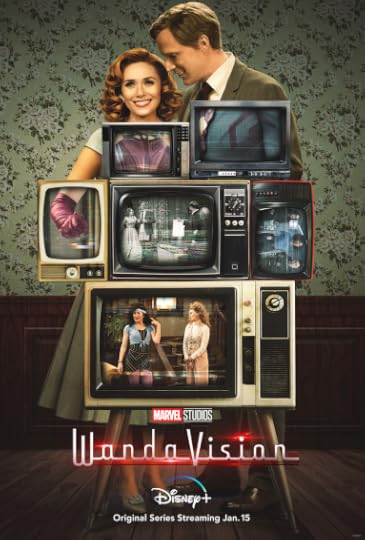
Understanding Wanda Maximoff and her superpowers requires some knowledge of her comic book origins as the Scarlet Witch. She is a member of the X-Men, the Avengers, and a love interest for the synthezoid, Vision. Despite being insanely powerful, Wanda is quite possibly one only woman in the contemporary Marvel Cinematic Universe who is not afraid to show vulverability. While characters like Black Widow, Captain Marvel, and Gamora reject traditional Disney Princess values, bottle up their emotions, and devote all their energy to attacking threats to civilized society, Wanda prefers to focus on her love for her family, making it all the more heartbreaking when she loses everyone she holds dear. Her pacifistic is a strength just as much as it is a weakness. Her lack of training makes it difficult for her to control or understand her supernatural abilities. She uses her powers in WandaVision to create a suburban utopia where she can live a peaceful life with Vision and put her crime-fighting days behind her. WandaVision's plot is an amalgamation of several Scarlet Witch comics, including a romance series from 1985 entitled The Vision and the Scarlet Witch, where she settles down with Vision to live an ordinary life in Leonia, New Jersey (or at least as normal a life as a mutant with reality-altering powers can have with a robot). This vintage limited series comic contains many gems that reveal Wanda's uniquely feminine tendencies, such as her desire to be a mother and her love of dressing up.

The simple "happily ever after" that Wanda desires in WandaVision is more complicated than usual because of the events that took place in the Marvel Cinematic Universe prior to the series. Vision was killed by Thanos in Aveners: Infinity War, meaning Wanda would have to use her powers to alter reality and bring him back to achieve the peaceful life of marital bliss that she longs for. What follows is an entertaining and emotional story about love, grief, and the dangers of trying to escape too deeply into a fantasy world. In this respect, the show is a deconstruction of the traditional Disney Princess fantasy. Similar to Crazy Ex-Girlfriend, WandaVision acknowledges that settling down with your prince and achieving your dreams does not guarantee that you will live "happily ever after" forever because life is never that simple. When we become adults, we must face the sad truth that happiness is fleeting. I deeply relate to Wanda's desire to escape from the troubles of reality and live in a fantasy world. That's one of the reasons I love princesses so much.
I think that WandaVision is a better retelling of the "Cinderella" trope than most Hallmark movies, and I think that's because it isn't trying to be a retelling of "Cinderella." It just happens to be a story with very similar themes. Cinderella suffers the loss of her only family and spends most of her life abused and tormented by the only people remaining in her life. Likewise, Wanda loses her entire family and spends a large chunk of her life being experimented on by Hydra like a lab rat. In all the time they spent studying her superpowers, she never had an opportunity to learn how to use them for her own needs, just like how Cinderella never realized she was being taken advantage of until her Fairy Godmother told her as much. Wanda thinks that by reviving Vision, she can run away with her prince and live her own happy ending. However, the show takes a dark turn by acknowledging that real life is not a fairy tale. Just because Wanda has the ability to change the world around her to suit her desires does not mean that she should. The only other "Cinderella" story to successfully convey this same message this is the novel Just Ella by Margaret Peterson Haddix.
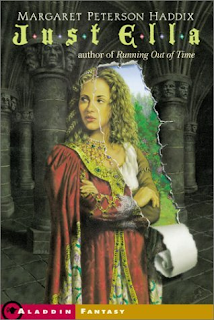
I'm a little sad that WandaVision has drawn to a close today after giving me something to look forward to every week for the past two months, but I am also glad that Disney+ blessed me with such a poignant story that pays homage to so many classic archetypes that I thought had gone out of style. The first two episodes of the show were particularly brilliant, filmed in black and white in front of a live studio audience and replicating fashion, jokes, special effects, and speech patterns from the 1950s and '60s. As the show gradually returns to the modern era, it transforms into a cautionary tale that we must be willing to face our problems head-on instead of trying to run away. Still, I believe that using fantasy to escape our problems can be therapeutic as long as it's taken in healthy doses. This transformation affects Wanda physically just as much as it does emotionally. Fate: The Winx Saga should take notes because this is how you do a successful live-action adult-oriented magical girl series.
February 28, 2021
Is Once Upon a Time Getting Rebooted?
In late 2019, ABC greenlit a new romance drama produced by and about Disney and fairy tale characters living in an enchanted forest. If that sounds familiar to you, that's because it is the exact formula that was used to create the 2011 ABC drama, Once Upon a Time, and by the same producers, no less. Once Upon a Time's seventh season was treated as a reboot of sorts and was, in many people's opinion, when the Disney-owned fairy tale drama finally jumped the shark. Why, then, would they think it's a good idea to do it all over again? Disney's behavior in recent years shows a dearth of creativity, as does Hollywood in general, so it isn't all that surprising that they would want to recreate a show that already has a fanbase, just as they've been tirelessly recreating their classic movies. However, the question remains that just because they can, does that mean they should?

From an objective standpoint, Once Upon a Time was not an original show, to begin with. There are many other properties that explored realms where fairy tale characters reside together, including Vertigo's Fables comics and the 2000 NBC miniseries, The 10th Kingdom. Once Upon a Time put an original spin on it with its protagonist, Emma Swan, a disgruntled modern-day woman who grew up in the real world and may have never learned of her fairy tale origins if her estranged son hadn't sought her out years later. Once Upon a Time conveyed a timeless theme about the power of family and hope, which made for a strong first season that started to fall apart as the show forced more and more unlikely familial relations to keep the plot interesting. The new series, entitled Epic, is promoted as a "romantic anthology," which might give it more in common with the underappreciated spinoff, Once Upon a Time in Wonderland. However, the reason that Wonderland is such a strong show is that it only ran for roughly half the length of a single season of Once Upon a Time and told a complete and moving love story in only 13 episodes. If Epic had been purchased as a limited series like Once Upon a Time in Wonderland, I would be less concerned, but knowing Disney, they will likely squeeze out every drop of content they can pull from it until there is nothing left.
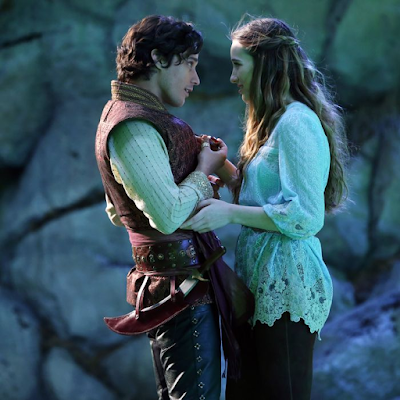
Reboots are a slippery slope because fans of the original often want to see the same thing again with fewer flaws, so too many changes can make them worse, whereas too few changes make them question why the property needed to be remade in the first place. The former may be the case with the upcoming live-action remake of Disney's The Little Mermaid. At first, I was excited to learn about the sweet and talented newcomer they found in to recreate the role of Ariel. Then I was excited to learn that Alan Menken was working with Lin-Manuel Miranda to write new music for the film. However, I was less excited to learn that these new songs include rap. Rapping and Disney princesses only go together in parodies or rap battle videos, not in the context of the story. Lin-Manuel Miranda had written such a beautiful "I want" song for Moana with "How Far I'll Go" that I had been hoping he would stick to the same format for The Little Mermaid. I would have even been happy with some of the original Broadway songs that were featured in 2019's live show starring Auli'i Cravalho as Ariel.
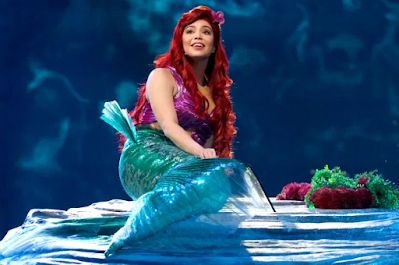
Unlike The Little Mermaid and Once Upon a Time in Wonderland, Epic is not being promoted as a reboot or a spinoff, which might be the worst transgression of all. Disney is hiring the same two producers to make the same show containing the same Disney-owned intellectual property and trying to promote it as something new. There is nothing original about this idea or even the fairy tales that inspired it. Disney has such a monopoly on princesses and fairy tales that all they ever want to do anymore is retell the same ancient stories and over and overs. What I would like to see from Epic is a new fantasy kingdom with original characters, original names, and an original story. It has been such a long time since Hollywood has introduced us to a princess we have never met before. Thanks to the decline of femininity in the media, it has been even longer since we have seen an original love story. Maybe this show will turn out to be all the things I've been hoping for since Once Upon a Time in Wonderland ended, but somehow, I doubt it.
Right now, I think the most original current Disney property is WandaVision. While this original Disney+ series draws its characters and story from various comics, movies, and classic sitcoms, the concept itself is something that has never been done before in this way. Instead of portraying a bunch of magical characters living in a mundane world like Once Upon a Time, WandaVision takes a bunch of ordinary New Jersey citizens and places them in a happy-go-lucky time-traveling sitcom. Not only does it fulfill the fantasy of living a trauma-free life that so many of us crave these days, but it also features what is in my opinion, the first Marvel character who is not afraid to show her femininity. My biggest issue with the Disney+ original movie Secret Society of Second-Born Royals is that it featured the same cookie-cutter rebellious feminist princess archetype that has been featured in every princess-related movie and TV show from the past decade. Wanda is the first superhero Disney has given us who would rather be a princess than a hero. I will have more to say about this when the finale airs later this week. In the meantime, I can only hope that Epic will take a page from WandaVision's book instead of trying to rehash the same old Once Upon a Time formula.
February 21, 2021
Sky Dancers Revisited
Sky Dancer dolls were one of the most popular toys for girls in the '90s. They weren't princesses per se, but the dolls granted the fantasy of becoming a faery princess and flying over a magical kingdom. Each one had a set of pastel dragonfly-like wings that spun around to launch the doll into the air at the pull of a string. The toys were so popular that they launched an animated series in 1996 under the same name. However, the dolls were more of a concept than a story, which made it difficult to streamline into one succinct set of characters with a direct conflict that they could resolve each week. In contrast, my favorite magical girl show from that time period, Princess Gwenevere and the Jewel Riders, had a fleshed cast that allowed it to tell a strong story with an intriguing beginning, middle, and end. Though I collected toys from both series, I have much clearer memories of the plot and characters from Jewel Riders than Sky Dancers. Thanks to my friends at the Jewel Riders Archive, I was able to revisit every episode of Sky Dancers and pinpoint their failure to tell a fantasy story for girls in the way that Jewel Riders succeeded.
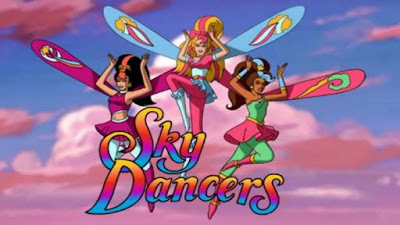
The most notable difference between Sky Dancers and other magical girl shows is that it contains both male and female protagonists. Slam and Breeze are in the same dance class as Angelica, Jade, and Camille, and get equal billing, which causes them to get in the way of the girls' character development while adding nothing of value to the story. This was an odd choice considering that I've never seen a male Sky Dancer doll. It's clear that the creators of the show were going for diversity and possibly hoping to attract a male audience as well, but that never works for shows like this. (Look up how Kids' WB managed to destroy the anime Cardcaptor Sakura for more on that.) That is not to say that female-oriented shows should not have any male characters in them. That would be silly. Princess Gwenevere and the Jewel Riders did a fantastic job of incorporating Drake, Josh, and Max from the Pack as supporting characters who showed up whenever it was necessary, while the main focus was on empowerment and friendship among the girls. Likewise, Winx Club, another animated series about girls who transform into sparkly flying creatures with superpowers, had a separate school for boys called Red Fountain, which allowed the Winx girls to have love interests that didn't interfere with their personal storylines at Alfea College for Fairies.

Slam and Breeze are not the only ones who prevent the show from having interesting characters. It is so focused on diversity that most of the protagonists are defined more by their backgrounds than their individual personalities. Each student comes from a different nationality, practices a different type of dance, and has a unique Sky Dancer superpower, but none of these things are related to who they are as people and what their goals are in life. Angelica is a blonde country girl who can freeze her enemies in pink sparkles (kind of like Taylor Swift before she became famous). Jade can turn invisible and has a father who was a scientist that she likes to bring up all the time. She is the only character to have an interesting backstory about her mother abandoning her, but it is never mentioned again after the only episode that addresses it. Camille is defined by her drama queen tendencies because she is the only girl who dates guys outside of the core group, which is kind of weird. Angelica has a crush on Breeze, whose entire personality is defined by his Native American heritage, but he doesn't seem that into her. The same applies to Jade and Slam, the hip-hop dancer, who is by far the most annoying character on the show and derails any opportunity for serious storytelling by making cheesy rhymes and jokes.
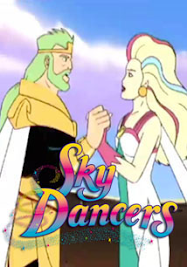
The fantasy worldbuilding in Sky Dancers, which isn't bad for this type of show. The Wingdom that the Sky Dancers fight to protect is a tiny universe of winged people that exists within a series of music boxes that their dance instructor, Skyla, keeps in her secret room behind the school. The show never addresses what would happen if one of these music boxes was broken or stolen. Even when a devastating earthquake strikes and destroys the entire dance academy, the music boxes are somehow fine. It would have been really interesting to learn how the music boxes in the outer world affect the magical Wingdom inside them. There are many different factions of the Wingdom with different types of inhabitants, including an underwater world of mermaids. It is exactly the type of world I liked to fantasize about as a little girl. Skyla is the de facto ruler of the Wingdom after her husband, King Skyler, sacrificed himself to get rid of his evil brother, Sky Clone. However, the "death spin" attack that he used, only got rid of him and turned Sky Clone into a green zombie-like creature who lives in the Nether World, but is able to come back and reign terror on the Wingdom whenever he wants. It is never addressed why the death spin didn't make Sky Clone disappear the same way it got rid of Skyler. Even when the Sky Dancers manage to bring King Skyler back, he just does the death spin again to restore their powers, leaving Queen Skyla devastated for a second time and making him quite possibly the most useless fantasy king ever. You can do better, Skyla.
The most frustrating thing about binge watching Sky Dancers is that the show has no resolution. Sky Clone is never defeated, Sklya and Skyler are never reunited (though she's probably better off without him), and we never learn what happens to the Sky Dancers after they graduate High Hope Academy. What I liked about Jewel Riders and Winx Club is that the story didn't remain static. The protagonists complete their goals at the end of each season and move on to something new. Sky Dancers ends with the implication that the five dancers will forever be bound to Queen Skyla and torn between the real world and the Wingdom, which I find kind of sad. Though I wouldn't care to see a gritty live-action reboot of Sky Dancers in the style of Fate: The Winx Saga, it does share some similarities to another modern live-action show, Find Me in Paris. The students at the Paris Opera Ballet School can't fly, but both shows feature a diverse group of dance students who are caught between performance rehearsals and dealing with supernatural conflicts. With just a few changes, Find Me in Paris could be the perfect modern-day version of Sky Dancers.
